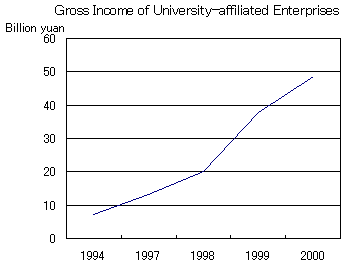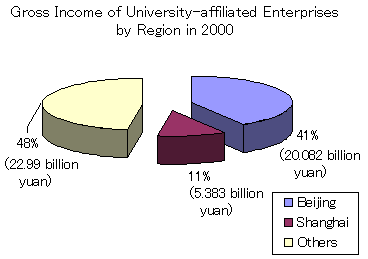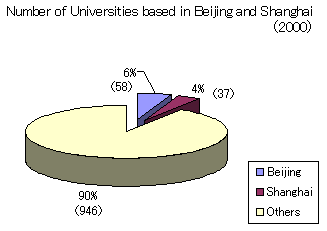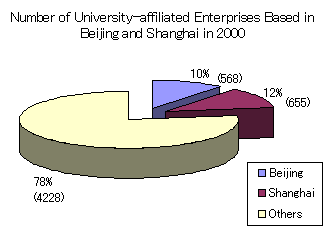Vigorous development of China's high-tech industry, centering on the field of information technology, has been arousing much interest in Japan. In particular, Zhongguancun Village in the northwestern part of Beijing has been attracting global attention as China's Silicon Valley. The area is home to some 30 universities - among which such leading universities as Tsinghua University and Peking University - and more than 200 research institutions including the Chinese Academy of Science as well as to a number of spinoff enterprises from those universities and research institutes. Some 20 years since the launch of reform in China, Zhongguancun Village has become a symbol of technological innovation system.
In the pre-reform period, China had promoted research and development centering on the fields of defense and heavy industry under the highly centralized ruling system modeling after the former Soviet Union. Under such state-led regime, R&D activities were undertaken, no by the private sector, but by research institutes under the State Council. Once embarking on the reform, however, the Chinese government began to shift away from this inefficient, former-Soviet style technology innovation system to introduce a new, U.S.-style system especially drawing upon Silicon Valley.
The driving force of Zhongguancun Village is a cluster of private high-tech companies called "minying keji qiye." And it is for this high concentration of high-tech enterprises including startups spinned off from universities and state-run research institute that Zhongguancun Village earned reputation as the Silicon Valley of China. Above all, a cluster of "xiaoban" or university spinoff companies, such as those set up by Peking University and Tsinghua University, have grown into the leading players of the Chinese high-tech industry. Hoping to evolve into a nation based on science and technology, Japan has been promoting university-based ventures. Still it is rare in Japan and elsewhere in the world that research-oriented universities themselves set up an enterprise as an affiliate as seen in China. More than 5,000 xiaoban university spinoffs exist in China, earning more than 48 billion yuan in combined income. Most of those companies are in Beijing, and those operated either by Peking University or Tsinghua University account for more than 30 percent of the income.

Zhongguancun Village and Development of University Spinoffs
China has a long history of university-affiliated enterprises (xiaoban enterprises), dating back to the "qingong jianxue" philosophy in the 1950s that called for studying while working. At that time, this philosophy was promoted mainly at elementary and junior high schools, rather than universities, and there was even a government policy to exempt income tax on schools implementing this idea. As to universities, some profit-making enterprises were observed in the 1960s such as a xiaoban factory operated by Peking University for the purpose of providing practical training to science and technological majors. Then, in the 1980s, following the government's launch of reform policy, a number of university-affiliated enterprises began to sprout. Facing dire fiscal straits, universities wanted to pull themselves away from budgetary difficulties and improve the poor living conditions of professors and university staff by commercializing research and development achievements. In the initial stage, activities of those university-affiliated enterprises centered on the "siji" or four technological fields including the development and transfer of basic technology and consulting services. For instance, Beida Fangzheng and Tsinghua Ziguang started respectively as Peking University's new technology company and Tsinghua University'-affiliated general developer of science and technology.
University-affiliated enterprises achieved spectacular in the wake of a famous speech delivered by the late Chinese leader Deng Xiaoping during his visit to the southern part of China that clearly set the reform course for the nation. Of total 1,010 universities in China, some 700 were operating enterprises in1995. According to the Chinese Ministry of Education's statistics in 2000, 364 universities operate 2,097 high-tech enterprises. Also, a ministry official said that those high-tech enterprises earned 36.8 billion yuan - 75 percent of universities total revenues - to generate more than 3.5 billion yuan in profits in 2000, having 230,000 employees including 78,000 specialists in science and technology. While paying 2.5 billion yuan in taxes to the state, those enterprises brought 1.685 billion yuan in combined profits to their affiliated universities. In the mean time, they retain their mission of providing practical training to university students, with some 780,000 students engaged in research activities in those enterprises.

Reform of University-affiliated Enterprises and Ownership Problem - Peking University Model v.s. Tsinghua University Model
Several reasons can be cited as to why Chinese universities opt to set up and operate an affiliate on their own. One reason is that universities have had no demand for their retained technology seeds for a long period of time. Under the former Soviet-style innovation system in the pre-reform period, no mechanism existed to transfer universities' research achievements to the industry, thus, technology transfer from universities to the industry was extremely difficult. Secondly, there is also a problem of universities' fiscal management. Chinese universities, funded by the state budget, receive budget allocation from the Finance Ministry and technically they can ask for an increase in budget allocation. As the government fiscal constraints became obvious in the 1990s, the allocation of education-related budget has been coming under strong retrenchment pressure. Given the circumstances, Peking University and Tsinghua University have been shouldering roughly half the expenses on their own, with profits from their affiliated enterprises covering major portion of such self-supporting funds. In other words, university-affiliated enterprises are counted on to make up for the shortage in the government-sponsored budget.
Today, however, relations between universities and their affiliated enterprises are being reexamined. An emerging trend is to strengthen a science park-based incubation function to make clearer distinction between education and research activities - which are the original role of universities - and the management of enterprises, shifting away from the conventional way of universities' direct ownership and management of their affiliated companies.
In the background of such development lies the ownership problem of university-affiliated enterprises. Most of the university-affiliated enterprises established before the promulgation of the 1994 Company Law are wholly owned by the state, and questions are now being raised over the lack of clarity as to what portion of equities belong to each of concerned parties, a university, the state and a university-affiliated enterprise. According to the Education Ministry, 90 percent of some 5,000 university-affiliated enterprises are wholly owned by the state, thus, ultimate responsibility should be theoretically held by the state. In reality, however, universities have substantial freedom over the management of their affiliated enterprises. And under such circumstances, universities would be held liable unlimitedly should the management of their affiliated corporate entity go wrong. That is, a university is taking a full risk for the management of its affiliated enterprise.
To this, the State Council is responding by putting in stricter discipline over university-affiliated enterprises to prevent their bankruptcies and subsequent negative impact on universities. Specifically, it has been laid down that university-affiliated enterprises must comply with the Company Law and the council decided to reform those under Peking University and Tsinghua University, setting a model for other university-affiliated enterprises. University-affiliated state-owned enterprises, by getting transformed into either a limited liability company or a joint-stock company as stipulated under the law, would become a separate entity independent from universities and be re-registered as such. With this, universities would become a sole stockholder of their affiliated enterprises and their liabilities would be limited to the amount of their paid in capital.
There are two types of management system - Peking University style and Tsinghua University style - depending on the ways of clarifying management responsibility by establishing a fire wall that separate corporate management and university's original function such as research activities and education. Peking University has a kind of "internal control system" with the management department within the university single-handedly taking charge of the management of affiliated enterprises. In contrast, Tsinghua University has opted for an "indirect management system" by founding Tsinghua University Enterprises Group as a holding company. In terms of firewall verification, the Tsinghua University style provide greater clarity of responsibility and accountability, and it is closer to the system adopted by U.S. universities or a Silicon Valley model in the U.S.
Problems Surrounding University-affiliated Enterprises
Reform of university-affiliated enterprises, which began in 1994, has accelerated on the heel of the progress of the 1996 university reform. Still, it is pointed out that the speed of reform is too slow and there remain some problems that need to be overcome.
First of all, the complexity concerning the ownership of university-affiliated enterprises straddling over respective universities and the state has not been fully solved. Some people say that university-affiliated enterprises are categorized as state-owned, thus, equities in those enterprises should fully belong to the state. However, the registration of those enterprises has a lot of ambiguity. Ownership problems arise in particular with those started up without receiving any capital injection from a university and at no expense of the government. For instance, if certain enterprise is to be registered as a company capitalized at 500,000 yuan, the founders of the enterprise may borrow that amount of money from a university they belong to, then return the money once registration is completed. Likewise, it is often the case that laboratories and other university facilities registered as assets of those enterprises are not actually used. In such a case, actual contributions by the university are hardly more than technologies and human resources. Should such a self-supporting enterprise succeed and generate high profits, as is the case with many university-affiliated enterprises, the inevitable question would arise as to how to distribute its assets. With the presence of mutually intertwined three-way relations - between a university and its affiliated enterprise, between the enterprise and the state, and between the state and the university - makes the problem extremely complex.
Secondly, there is also a problem concerning the preferential tax treatments. University-affiliated enterprises are entitled to a series of preferential taxes including income tax. Once they are transformed into a limited liability company, they might lose some of those tax benefits. Also, because a limited liability company must distribute profits based on the number of shares, an approval of the board must be sought to provide fund to its parent university, making it difficult for universities to tap its affiliated enterprises for fund.
In case of University of Petroleum, Beijing, its affiliated oil refinery company was recently transformed into a limited liability company. While providing practical training to university students, the company has been producing 400,000 tons of refined oil annually. The company has been providing practical training for university students. But the Ministry of Foreign Trade and Economic Cooperation is expected to decide on the closure of oil refineries producing no more than 1 million tons of oil due to environmental concerns. Given its economic efficiency balanced against environmental concerns, the refinery at University of Petroleum will most likely be closed. No fixed rules exist as to what rules to apply to university-affiliated companies which are operated for the purpose of research and education.
Apart from leading universities in Beijing and Shanghai, quite a few university-operated enterprises face management difficulties. It is thus required to set a certain limit for liabilities incurred to a university in the event that its affiliated enterprise goes under. And by doing so, it would become possible to create an environment that allow for universities to concentrate, to a greater extent, on their original duties of education and research activities. Newly emerging management mechanisms that clearly separate corporate management and university management and, in particular, recent reform experience at Tsinghua University, may hold the key to the success of the ongoing reform of university-affiliated enterprises.
*Sources:
Compiled from "Chinese Statistical Yearbook 2001" and "China report on science and technology development 2000," the Ministry of Education.


